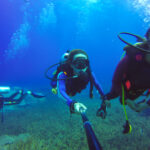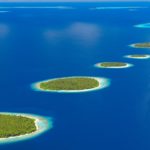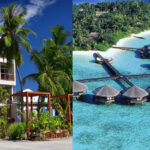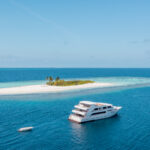The Greater Malé area of the Maldives, encompassing the vibrant capital city of Malé along with its surrounding islands such as Hulhumalé, Villimalé, and more, offers a unique blend of urban buzz and serene island life.

Malé: The Cultural Pulse of the Maldives At the heart of the Maldives lies Malé, the vibrant capital where history and modernity dance along the narrow streets. As the political and economic hub, Malé boasts a rich cultural tapestry woven with grand mosques, bustling markets, and parks. Its compact size is deceptive, packed as it is with endless experiences that range from historical tours to waterfront recreation.
Hulhumalé: The Future of Island Urbanism A stone’s throw from the capital, Hulhumalé is a reclaimed island designed as a sustainable urban area to alleviate congestion in Malé. Known as the Maldives’ first smart city, Hulhumalé is planned with broad avenues, parks, and beaches, setting the standard for future cities with its innovative approach to community living and environmental sustainability.
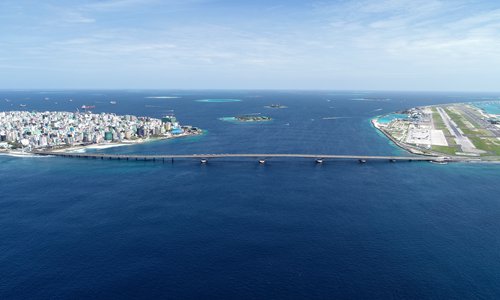
Villimalé: The Eco-friendly Escape Just a ferry ride away from Malé, Villimalé offers a serene retreat with its car-free roads and abundant green spaces. This island’s history as a royal retreat and prison island adds layers to its tranquil charm. Today, Villimalé is celebrated for its vigorous environmental initiatives, tranquil beaches, and community-driven lifestyle, making it a perfect example of sustainable tourism in action.
Malé: The Cultural Heartbeat of the Maldives
Malé is not only the capital of the Maldives but also its most densely populated island, pulsating with a vibrant culture and rich history that captures the essence of this island nation. This city, while small in area, bursts with life, offering visitors a complex and captivating mosaic of modernity interlaced with tradition.
The Old Friday Mosque
Central to Malé’s historical narrative is the Old Friday Mosque, known locally as Hukuru Miskiy. Constructed in 1658, this mosque is a marvel of traditional Maldivian architecture, made from coral stone into which intricate designs and Quranic script are carved. The mosque’s interior is adorned with woodwork and lacquer that tell the tales of sultans who once walked its halls. This site not only serves as a place of worship but also as a gateway to the rich Islamic heritage of the Maldives.
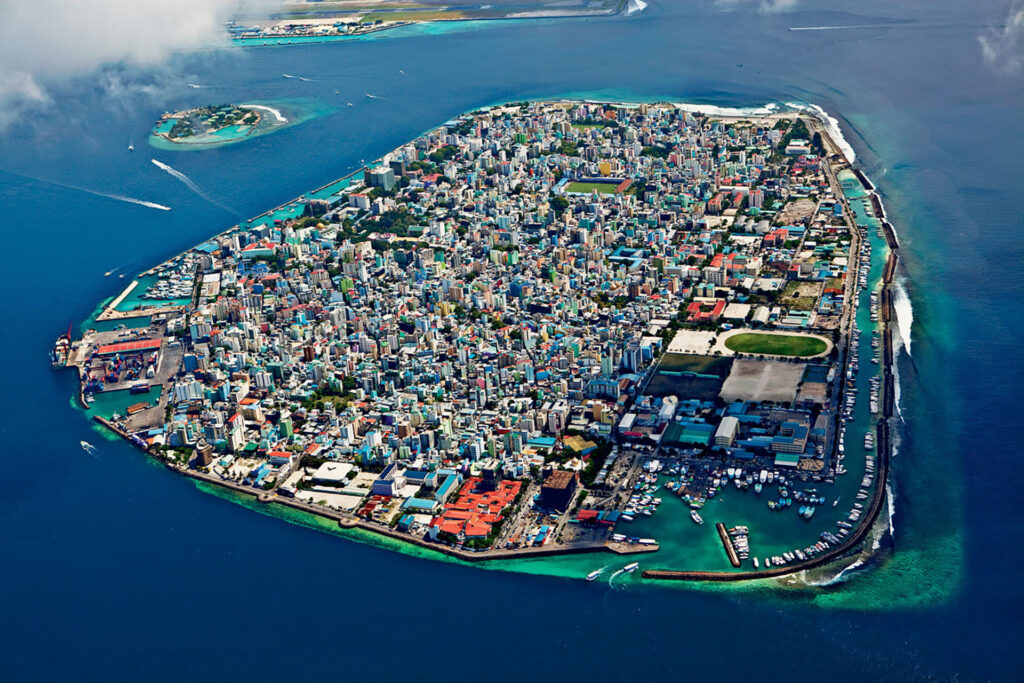
The Grand Friday Mosque
In contrast to the ancient Hukuru Miskiy, the Grand Friday Mosque, or Masjid-al-Sultan Muhammad Thakurufaanu Al Auzam, stands as a symbol of the country’s Islamic faith with its large golden dome and majestic minarets visible from nearly any point in the city. Completed in 1984, it can accommodate over 5,000 worshippers, reflecting the religious devotion of the Maldivian people.
National Museum
Situated in Sultan Park, which was part of the Sultan’s palace complex, the National Museum of Malé houses artifacts that span the breadth of Maldivian history, from its early Buddhist era up to its Islamic dominance. The museum’s collection includes thrones, costumes, weapons, and religious paraphernalia that offer a tangible connection to the Maldives’ regal and spiritual past.
Vibrant Markets
The fish market and local bazaars stand as lively hubs of daily activity in Malé. The fish market, in particular, offers a direct view into the Maldivian way of life, revolving around the ocean and its bounty. Here, fishermen unload their daily catch, providing fresh tuna, grouper, and other seafood, which are staples of Maldivian cuisine. Nearby, the local markets burst with the colors and scents of tropical fruits, local snacks, and artisanal crafts, drawing both locals and tourists into their lively atmosphere.

Artificial Beaches
Despite being the capital, Malé understands the need for natural retreats within its urban sprawl. The Artificial Beach and Rasfannu Beach are man-made havens where locals and visitors alike can enjoy the sun and sea just steps away from the urban core. These beaches are equipped with excellent facilities for families to relax or indulge in water sports, reflecting the Maldivian ethos of living in harmony with the sea.

Sultan Park
A remnant of the royal past, Sultan Park is a tranquil green oasis amidst the city hustle. It offers a peaceful escape with its lush foliage, shaded walkways, and quiet corners, ideal for those seeking a moment of serenity or a leisurely stroll.
Malé City Tour
For those looking to delve deeper into the city’s charms, various guided tours can lead you through hidden alleys, past historic landmarks, and into the bustling marketplaces where the city’s heart truly beats. These tours offer insights not just into Malé’s past but also its dynamic present.
Water Sports and Ocean Adventures
The surrounding lagoon of Malé provides ample opportunities for snorkeling, diving, and jet-skiing, allowing adventurers to explore the vibrant coral reefs and marine life that lie beneath the surface of the crystal-clear waters.
Hulhumalé: A Visionary Urban Experiment
Hulhumalé stands as a testament to the Maldives’ bold approach to urban planning and environmental challenges. This man-made island was conceived as a solution to the overcrowding in Malé and as a proactive measure against the threat of rising sea levels. Just a bridge away from the bustling capital and Velana International Airport, Hulhumalé represents a unique blend of innovation, sustainability, and modern living.

The Genesis of Hulhumalé
Developed by the Housing Development Corporation, the island began to take shape in 1997 through an ambitious land reclamation project. The idea was not just to alleviate congestion in Malé but to create a space that could embody the future of sustainable urban development. Today, Hulhumalé is a thriving community with its distinct skyline, designed to accommodate up to 240,000 residents by the mid-2020s.
Architectural and Urban Design
Hulhumalé is laid out with a meticulous urban plan that emphasizes efficiency and sustainability. Wide boulevards lined with green spaces contrast sharply with the narrow, crowded streets of Malé. The city’s layout promotes airflow to keep the streets cooler, and buildings are constructed with energy efficiency in mind. This careful planning extends to the island’s infrastructure, which includes advanced waste management systems and provisions for stormwater drainage to protect against flooding—a critical feature for an island nation vulnerable to climate change.
Living and Working in Hulhumalé
Residential Development
The residential zones in Hulhumalé are a mix of high-rise apartments and smaller townhouses, offering housing solutions that cater to a diverse population. These homes are part of a broader plan to provide affordable housing while promoting a high quality of life. Each residential area is designed to be self-sufficient, with access to amenities like schools, healthcare facilities, and shopping areas within walking distance.
Commercial and Economic Growth
Hulhumalé is not just a residential hub but also a burgeoning center for business. With its proximity to the international airport and Malé, it is an attractive location for both local and international businesses. The island’s commercial sector is bolstered by business-friendly policies and state-of-the-art facilities, which include a business park and numerous commercial plazas that host a variety of enterprises, from startups to established companies.
Green Spaces and Recreation
One of the island’s crowning jewels is Hulhumalé Central Park, a sprawling green space at the heart of the island. This park is not only a recreational area but also serves an ecological purpose, housing native plant species and providing a habitat for local wildlife. The park includes playgrounds, sports facilities, and walking trails, making it a focal point for community life.

The beaches around Hulhumalé are another key feature, meticulously maintained and featuring facilities that encourage sports and outdoor activities. These beaches are designed to be more than just tourist destinations; they are vital community spaces for residents and visitors alike.
Cultural and Social Integration
As a new city, Hulhumalé is also a melting pot of cultures. Various cultural festivals and events are held throughout the year, which helps to integrate the diverse populations that call the island home. These events are not only a showcase of Maldivian culture but also include international influences, reflecting the global community residing in Hulhumalé.
The Future Vision
Hulhumalé is continually evolving, with each phase of development bringing new innovations. Plans for the future include the integration of smart technology in public services, renewable energy projects, and further enhancements to the urban environment. The island is seen as a living laboratory for testing new technologies and urban planning theories before they are implemented elsewhere in the country.
Villimalé: A Tranquil Sanctuary
Villimalé, a small island within sight of the Maldivian capital, Malé, presents a stark contrast to its bustling neighbor. Known for its tranquility and green initiatives, Villimalé is a testament to the Maldives’ commitment to sustainability and environmental consciousness. This island, once a quiet getaway for the sultans, now offers a peaceful retreat from the rapid urbanization seen in nearby Malé.

Historical Roots and Transformation
Historically, Villimalé served varied roles—from a royal retreat to a penal colony, each phase contributing layers to its rich tapestry of history. Today, it stands as a model of ecological preservation and community-oriented living. The island’s past is still palpable in its quiet streets and the relaxed demeanor of its residents, who are deeply connected to their environment.
Eco-conscious Living
Villimalé is perhaps most notable for its stringent environmental policies. The island is a no-go zone for motorized vehicles; instead, residents and visitors traverse by foot or cycle along its sandy paths, which adds to the serene atmosphere. This eco-friendly transportation policy not only preserves the island’s tranquility but also significantly reduces its carbon footprint.
Green Initiatives
The local community is actively engaged in various sustainability projects. From coral planting to beach clean-ups, the efforts are community-driven and supported by various non-governmental organizations that aim to protect the island’s natural beauty and biodiversity. These initiatives also serve as educational platforms for both locals and tourists, emphasizing the importance of environmental stewardship.
Cultural and Recreational Activities
Eco Walking Tours
Villimalé offers eco walking tours that are both enlightening and engaging. These tours provide insights into the island’s history, its ecological initiatives, and the local lifestyle. Led by knowledgeable locals, they often include visits to historical sites, themed gardens, and key community projects.
Hedika Tasting
Hedika, traditional Maldivian savory and sweet snacks, are a cultural staple and a must-try for any visitor. Local cafés serve these treats, typically enjoyed with black tea, offering a taste of genuine Maldivian hospitality and culinary traditions.
Marine Conservation Efforts
Coral Plantation Activities
Villimalé is actively involved in coral conservation, with several coral nurseries around the island. These conservation efforts are crucial in combating the effects of coral bleaching and maintaining healthy reef ecosystems. Visitors can participate in planting corals, which not only helps the environment but also provides a deeper understanding of marine ecosystems.
Leisure and Wellness
Public Beaches
The island’s beaches, like the Villingili Public Beach, are known for their shallow, clear waters, making them ideal for families with children. These beaches are less commercialized than those in Malé, offering a more relaxed vibe and unspoiled natural beauty.
BBQ Point
The BBQ Point is a popular spot among locals and visitors for gatherings and informal dining. Equipped with grills and picnic tables, it embodies the island’s community spirit and love for the outdoors.
A Living Model of Sustainable Tourism
Villimalé is not just a destination; it’s a living model of sustainable tourism and community involvement. It challenges visitors to rethink their environmental impact and encourages a slower, more mindful approach to travel. The island’s initiatives and lifestyle promote a balance between development and conservation, offering lessons in sustainability that are applicable worldwide.
Why visit Trio?
Each island in the Greater Malé area offers a distinct flavor of Maldivian life and culture, providing visitors with a diverse range of experiences from the hustle of city life to the quietude of eco-friendly escapes. Whether you’re seeking the cultural depth of Malé, the innovative spirit of Hulhumalé, or the serene sustainability of Villimalé, the Greater Malé area beckons with its unique blend of experiences.

